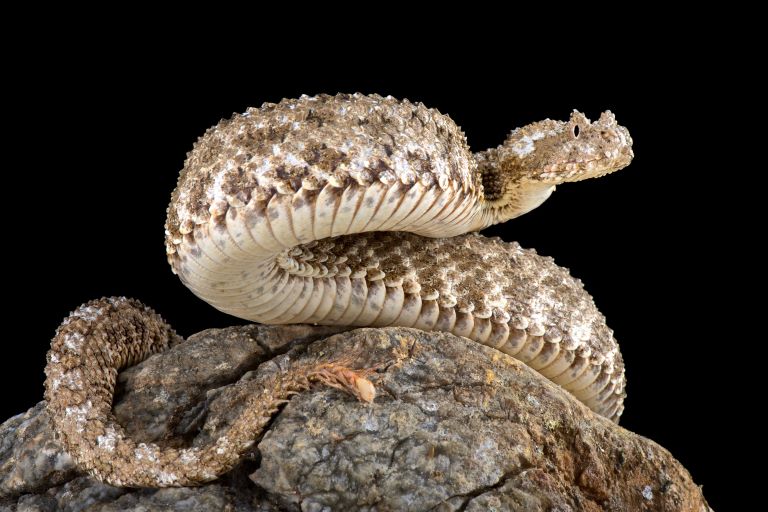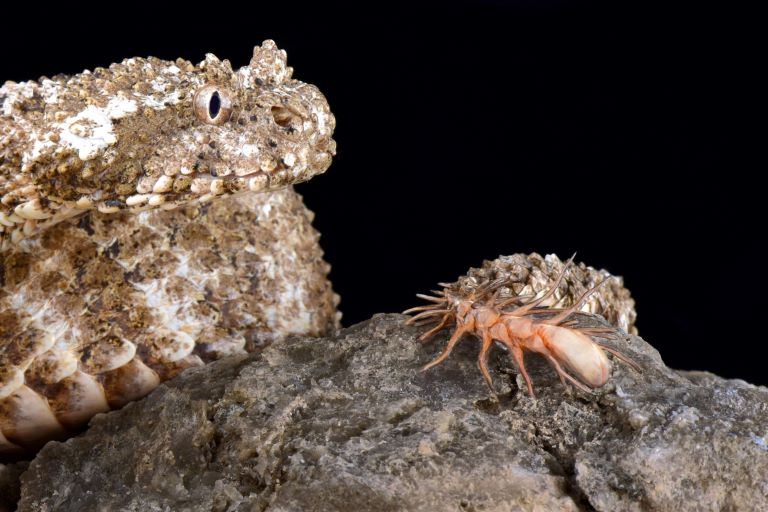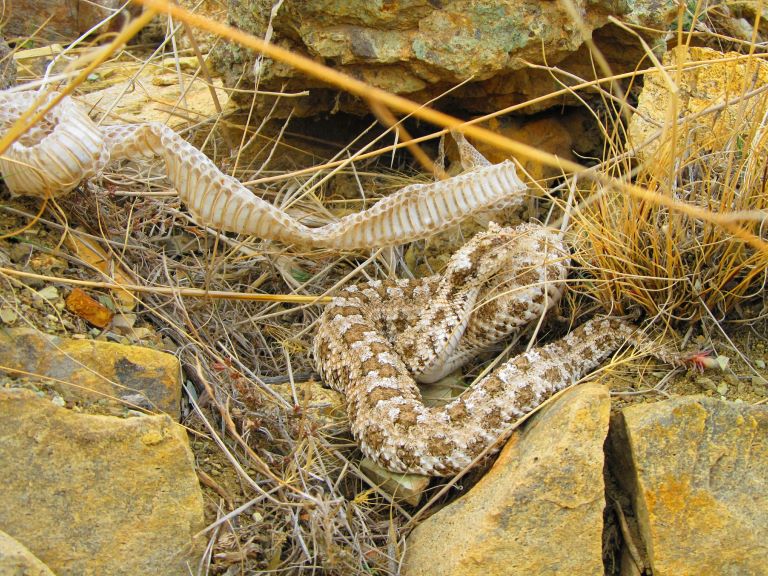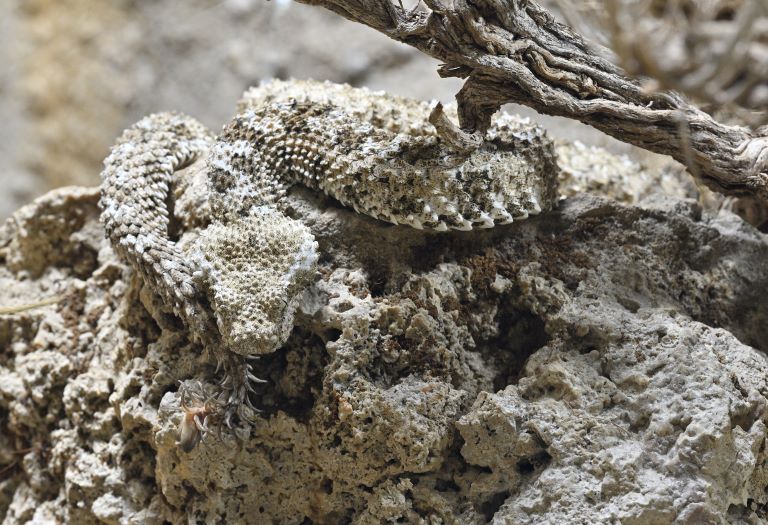Spider-Tailed Horned Viper Profile
Fact is often far creepier than fiction.
Dr. Evil suggested confronting his enemies by way of sharks with lasers, Homer Simpson spoke of dogs with bees in their mouths. The great Michael Madsen gave his prestigious name to the unforgivable production of Piranhaconda, yet none of these imaginary monstrosities can hold a candle to Mother Nature.
If snakes didn’t frighten you enough, now they come with scary spiders as standard.

Spider-Tailed Horned Viper Facts Overview
| Habitat: | Rock crevices, mountains |
| Location: | Western Iran and Eastern Iraq |
| Lifespan: | Unknown |
| Size: | 30-60 cm (12-24 in) |
| Weight: | 35-85 g (1.2-3 oz) |
| Colour: | Sandy/pale brown |
| Diet: | Mostly birds, some insects, mammals |
| Predators: | Some birds of prey |
| Top Speed: | Slow |
| No. of Species: | 1 |
| Conservation Status: | Near Threatened (IUCN) |
Rattlesnakes are well-known vipers who use the tips of their tails as an intimidation tactic. The gorgeous Amazonian palm viper waves a pink tip as a warning, but also, seemingly, to lure lizards to their doom.
But the spider-tailed viper has perhaps the most horrifying and detailed caudal lure of any snake.
This is a snake that’s so poorly understood it was only recognised as its own species in 2006. What we do know is that it’s evolved the incredible ability to take advantage of transients using puppetry and specialised chemical weapons.
Interesting Spider-Tailed Horned ViperFacts
1. It’s hard to watch
Vipers are well known for using the tips of their tails to their advantage. Rattlesnakes wave them as an intimidation tactic and are imitated by many other species.
The gorgeous Amazonian palm viper wiggles a pink tip as a warning, as well, it seems, as to lure lizards to their doom.
Juvenile bamboo vipers appear to have some form of vibrating temptation at their only extremity, too.
But the spider-tailed viper has perhaps the most horrifying and detailed caudal lure of any snake. This reptile is able to replicate the creepiness of a spider with a fascinating and intricate appendage not found anywhere else.
This appendage is so strange, it was originally thought to be some kind of parasite or deformity, but it turned out to be an outstanding and creepy example of mimicry.
It’s made from the final two lower scales on the snake’s tail that have evolved to be much larger, and a set of side scales that stick out like the legs of an arachnid. 1 2
2. Natural selection is unintelligent
Have you ever wondered how a snake knows to hiss when they don’t have any ears to hear it? Similarly, without ever needing to come across such a spider, this viper has evolved to grow one out of its back end.
This is a perfect example of how evolution creates shapes and sounds unintelligently and demonstrates how the environmental pressure carves out morphologies.
Evolution isn’t driven by conscious efforts or desires. For this lure to be intelligently motivated, the snake would have to understand that its prey is attracted to spiders.
Then, it would have to carefully design the shape of a spider, accurately enough to fool its prey. Instead, over millions of years, snakes with spider-like appendages accidentally fooled animals into getting within striking distance.
The natural genetic variety among the vipers would throw out lures of varying quality, and those that most closely resembled spiders increased the reproductive success of their owners. Those that didn’t, dropped them out of the gene pool.
Over time, snakes with the best lures became dominant and passed on the genetic code to replicate them in their offspring.
Interestingly, this lure appears to have evolved independently from that of the rattlesnake, as it uses soft tissue, as opposed to bone fragments, suggesting a different evolutionary path.

3. This one’s a bird specialist
The bulbous abdomen and creepy legs of a spider are immediately recognisable in this lure, but equally impressive is the way the snake has perfected its motion.
When sitting in ambush, it writhes the tip of the tail around, jiggling the legs and perfectly mimicking the uncomfortable scuttle of a spider across the rocks.
And this mimicry is enough to persuade hungry birds, who rush in to feed on the juicy arachnid, only to be grasped and injected by the viper’s killer fangs. 3
4. It preys on tourists
Curiously, this exceptional quirk of evolution isn’t good enough to fool the residents. Birds are smarter than they’re given credit for, and it appears to researchers that the spider trick is getting old among the local Avians.
But, there are enough migratory species that pass through the area to sustain a cold-blooded killer, and these are the unlucky few who get snapped up by the snake. 4
5. This is a unique cocktail
One of the interesting paths of research that’s slowly coming out of this line of snakes is focused on what venom cocktails can tell us about the taxonomy of the animal.
Counter-intuitively, viper venom differs a lot between closely related species, and when tested against human blood, functions on different coagulant factors.
So, while the particular makeup of spider-tailed horned viper venom doesn’t tell us a lot about its closest relatives, it does provide an identifier for the species, should you ever be at a crime scene involving snake venom.
The unique composition is almost certainly an adaptation to a specific type of prey, which in this snake’s case, is a bird. 5

6. Their venom is designed for birds
It’s not only the lure that’s well adapted for capturing birds, as with many venomous specialists, this horned viper has evolved a particular mix of proteins that are specifically targeted at birds.
Formed mostly of cytotoxins, the venom rapidly destroys cells of all kinds. There is some neurotoxic component to it, but the most notable feature of this death juice is its ability to coagulate blood.
Sometimes within 13 seconds of exposure, the blood of the poor victim becomes too thick to manoeuvre around the body.
Interestingly, this venom is also very effective against amphibians, suggesting that the youngsters may feast on frogs until they get their wiggle down pat.
So far, no recorded human envenomations exist, and without volunteers, it’ll be a while before we know how uncomfortable a bite from this snake is.
7. Their main threats are from scared locals
Despite their apparent lack of danger, these snakes are primarily persecuted by a population of hysterical humans.
In some parts of the world – particularly in Buddhist countries – snakes are treated with respect as part of nature’s diverse portfolio. Almost everywhere else, they’re slaughtered indiscriminately out of phobic concern they might haunt people’s dreams for eternity.
A snake with a scary spider attached to it doesn’t fare well in the land of Ophidiophobes, and this particular animal is mostly killed by villagers who don’t know any better.

Spider-Tailed Horned Viper Fact-File Summary
Scientific Classification
| Kingdom: | Animalia |
| Phylum: | Chordata |
| Class: | Reptilia |
| Order: | Squamata |
| Family: | Viperidae |
| Genus: | Pseudocerastes |
| Species: | Urarachnoides |
Fact Sources & References
- (2015), “The remarkable spider-tailed viper”, Why Evolution is True.
- Harry W. Greene (1972), “Notes on the Use of Caudal Lures by Arboreal Green Pit Vipers”, JSTOR.
- SciNews (2016), “Iranian spider-tailed viper tricks bird”, YouTube.
- Dr Claire Asher (2021), “What is the spider-tailed horned viper?”, Science Focus.
- Bianca op den Brouw (2020), “Extensive Variation in the Activities of Pseudocerastes and Eristicophis Viper Venoms Suggests Divergent Envenoming Strategies Are Used for Prey Capture”, MDPI.
